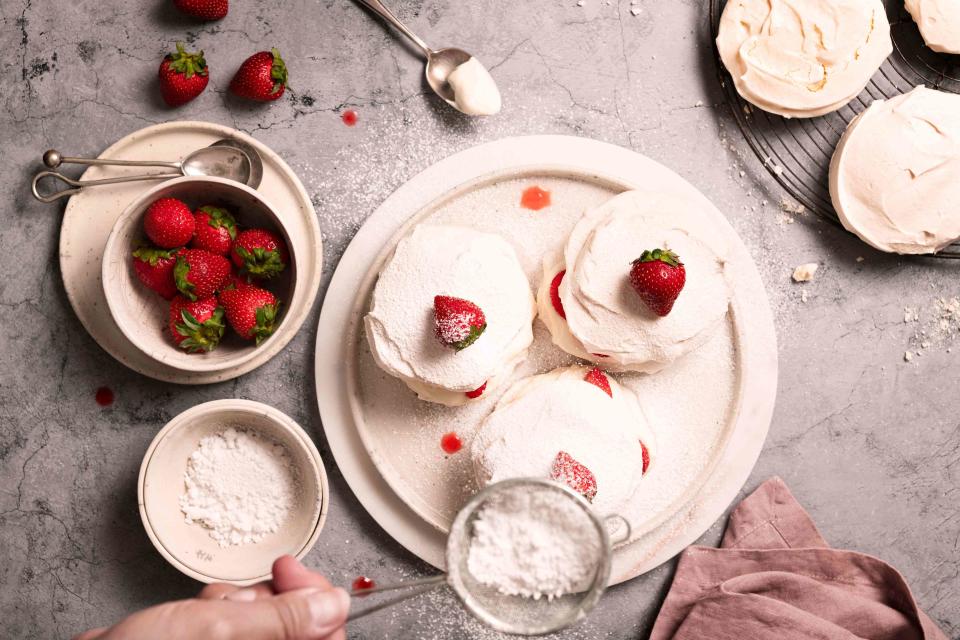Four Ways to Make Meringue and Up Your Dessert Game
Here’s everything you need to know to whip up something light and fluffy for Baked Alaska, macarons, pies, and pavlovas.

Monica Bertolazzi / Getty Images
Meringue is the best thing an egg white can aspire to be. A simple combination of egg white and sugar, this magical fluff can be light as air, chewy or crisp, crunchy or squishy. It can top a pie, frost a cake, or serve as the basis for all sorts of fabulous desserts, from elegant macarons to gooey marshmallows.
Types of meringue
There are four kinds of meringue, each with a different method and purpose. Here’s how to know what to whip up and when and how to use them.
Related:16 Heavenly Meringue Desserts
French meringue
These simple meringues are made by slowly adding sugar to egg whites as they whip. This mix is best used in making for which the meringue will be cooked after it is whipped. French meringue is often used for pavlovas, as well as souffles, cookies, cakes, roulades, atop pies, and for meringue decorations, like these meringue mushrooms that go on a bûche de Noël, these meringues paired with fruit, and this iconic restaurant dessert.
Italian meringue
For this type of meringue, you melt sugar into a warm syrup and then slowly incorporate it into the whites while whipping them. The method creates a stable meringue that is also “cooked” and safe to eat without further baking. It is great for pie crusts, buttercream frostings or macarons, and also makes a lovely topping for pie or a Baked Alaska.
Related:Macaron vs. Macaroon: What’s the Difference?
Swiss meringue
For a Swiss meringue, the whites and sugar are combined over a double boiler and whisked over a double boiler for a very stable cooked meringue that is a bit more dense than French. This thickness makes it great for making meringues that need to keep their shape, like cookies, or for topping pies or this summery blueberry buttercream.
Marshmallow meringue
This is usually either an Italian- or Swiss-style meringue with gelatin sometimes added to help it set and firm up the structure for a fluffy, light meringue topping or a doughnut filling.
Tips for making the best meringue
In all cases, you will need to follow some basic rules. For starters, older whites whip better than fresh ones, so if you want to make meringues, buy your eggs at least a week in advance. Jacques Torres uses meringue powder, which is made from dehydrated egg whites, as a stabilizer when using fresh eggs.
Egg will separate better when cold, but whip better at room temperature, so separate them first into airtight containers, then let the egg whites come to room temperature before whipping them for maximum volume.
The tiniest speck of yolk will hinder whipping, as will grease or dust or water, so clean and dry your bowl well (Paola Velez cleans her bowl and whisk with vinegar or lemon juice before making meringue), and separate eggs one at a time into a small bowl before adding to the mixing bowl, so that if you accidentally break a yolk, you only lose that one egg and not the whole bowl of whites.
Some recipes will call for acidulating the meringue with vinegar, lemon juice or cream of tartar to stabilize the foam. This addition can help improve the texture of the whipped egg whites and stabilize them, so you avoid overbeating the meringue. It’s useful when you really want the meringue to hold shape, as with kisses, or to have a good marshmallowy chew, as with pavlova. French meringue is the least stable of the different types, so adding some acid to this style can be useful for a more stable result.
For more Food & Wine news, make sure to sign up for our newsletter!
Read the original article on Food & Wine.

